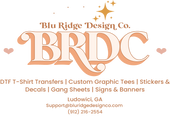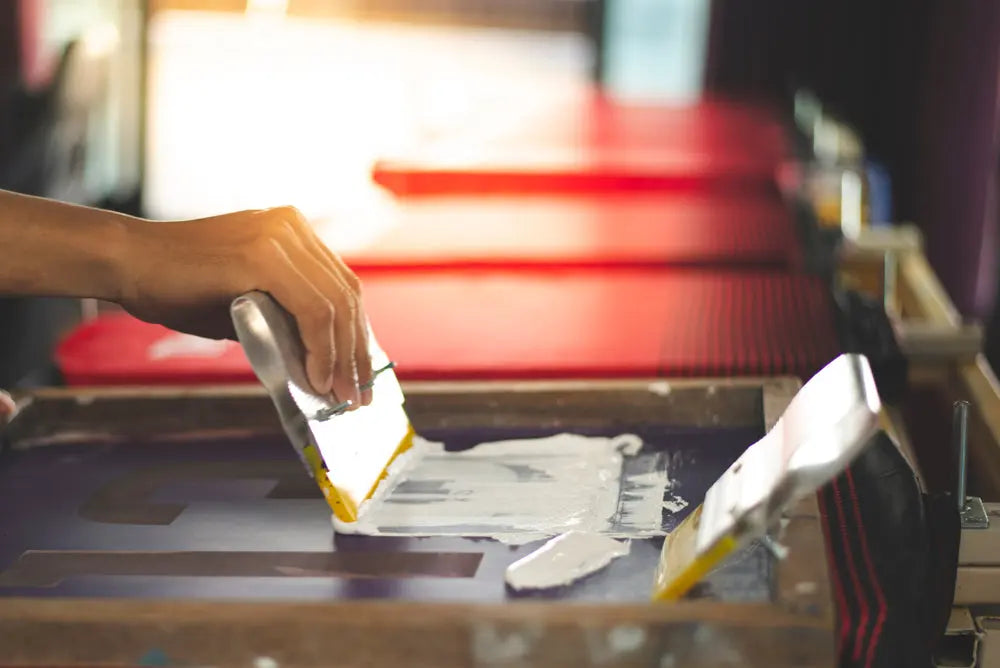At the crossroads of print methods for your upcoming project or business plan? Deciding between DTF printing and screen printing can seem daunting. Our detailed guide is here to illuminate your path, delving into each technique's features, differences, and advantages, as well as potential challenges. With knowledge and clarity, you're poised to make the wise choice on your journey. Let's emgandgbark on this exploration.
Understanding the Basics
What is DTF Printing?
Direct to Film (DTF) printing is a cutting-edge customization method that involves printing designs directly onto a film, which is then coated with adhesive powder.
The design is transferred to a substrate (usually fabric) with a heat press, resulting in durable, vibrant, high-quality prints. DTF shines in its versatility, allowing intricate, full-color designs on a wide range of materials, including hard-to-print surfaces like dark and textured fabrics.
- Versatility and Color Range: DTF's ability to handle complex, multi-color designs with ease is unmatched, making it ideal for detailed graphics on a variety of materials.
What is Screen Printing?
Screen printing, a traditional method, involves creating a stencil (or screen) for each color in a design. Ink is pushed through these stencils onto the print surface, one color at a time, combining to achieve the final look. Known for its durability and vibrant colors, screen printing is a popular choice for bulk orders due to cost-effectiveness at large volumes.
- Durability and Vibrancy: Screen printing excels in producing bright, durable prints, perfect for designs requiring high visual impact and longevity.
Screen Print Transfers
A hybrid method, screen print transfers involve printing a design onto special release paper using screen printing techniques. These designs can then be heat pressed onto a substrate, offering the benefits of screen printing with added convenience. This method is particularly beneficial for businesses looking to print in bulk while retaining the ability to apply designs flexibly.
Read our full blog on Top 5 online stores that sell ready to press DTF transfer designs
Making the Right Choice for Your Business
Cost and Efficiency: An In-depth Analysis
-
Setup and Running Costs: The initial setup for screen printing can be notably high, largely due to the necessity of creating unique screens for each color in a design. This process not only demands a significant amount of labor but also materials, making it less cost-effective for small runs. In contrast, DTF and screen print transfers circumvent this issue with their digital processes, which eliminate the need for physical screens and reduce labor costs. This modern approach allows for a more streamlined setup, making it a financially viable option for businesses looking to produce high-quality, small to medium-sized batches.
- Design Complexity: DTF's digital nature shines when handling complex designs. The ability to print full-color images in a single pass without the need for creating multiple screens allows for a higher degree of detail and a broader color palette. This capability makes DTF particularly appealing for designs that feature gradients, intricate patterns, or a wide range of hues. Screen printing, while exceptionally durable and vibrant for each color applied, is better suited for designs with limited colors. The process of screen printing involves layering colors through separate screens, which can limit the complexity of the final design or increase the cost and production time for designs with many colors.
Versatility: Material Matters
- Material Compatibility: DTF's adaptability extends to its compatibility with a diverse array of materials, including but not limited to, cotton, polyester, blends, and even non-textile substrates. This versatility is particularly beneficial for businesses that offer a wide range of products. Screen printing, while highly effective on cotton and some synthetic fabrics, requires specific ink formulations to adhere properly to different materials. This necessity can pose challenges when working with dark or textured fabrics, as additional preparatory steps, such as applying a base layer of white ink, may be needed to ensure color vibrancy and print quality.
Turnaround Time: Speed and Efficiency
- Efficiency in Production: DTF's streamlined process offers a significant advantage in turnaround time, especially for orders that demand a multitude of colors or have a complex design. Since DTF prints all colors in one pass, it eliminates the need for multiple screens and the associated drying times between colors, drastically reducing overall production time. Screen printing, with its requirement for individual screens for each color and drying times, can be slower, making it less ideal for projects with tight deadlines or those requiring rapid production cycles.
Durability: Longevity and Wear
-
Endurance of Prints: The durability of a print is paramount for products that will undergo frequent washing or heavy use. Screen printing has long been heralded for its durable prints, which can endure extensive wear and washing cycles, especially when applied directly to the fabric. The thickness of the ink layer in screen printing contributes to this resilience. DTF prints, while also durable and capable of withstanding many washes, achieve their longevity through different means. The adhesive powder used in DTF printing ensures that the print adheres strongly to the fabric, and when applied correctly, these prints can rival the durability of screen-printed designs. Proper care and washing can extend the life of both DTF and screen-printed items, maintaining their vibrancy and integrity over time.
- In conclusion, the choice between DTF and screen printing hinges on a comprehensive evaluation of your business's specific needs, including the complexity of your designs, the variety of materials you intend to print on, the quantity of your production runs, and the urgency of your orders. While screen printing remains a stalwart for high-volume, simpler designs due to its cost-effectiveness and durability, DTF offers unparalleled flexibility and efficiency for intricate, colorful designs on a wide range of materials, making it an ideal choice for businesses seeking to maximize their creative potential and operational efficiency.
Quality of Print: Beyond Surface Comparisons
- DTF Printing elevates the quality of prints to new heights, delivering high-definition, photorealistic outcomes that are hard to match. This method is particularly beneficial for designs that demand sharp details or a wide array of colors. The technology behind DTF allows for a level of precision and clarity that can bring the most intricate designs to life, making it ideal for artists or brands that prioritize image quality above all else.
- Screen Printing, renowned for its vibrant, opaque colors, thrives in environments where boldness and simplicity are key. The tactile texture it imparts to products adds a premium feel that DTF prints may not replicate. This method suits designs that are less complex but require a strong visual impact, such as logos and graphic tees with limited color palettes.
Color Reproduction: The Spectrum of Possibilities
- DTF's digital process excels in reproducing a wide color spectrum in a single print, offering an unparalleled advantage for designs that feature gradients, shades, and intricate color details. This capability ensures that even the most colorful and complex designs are reproduced with accuracy and vibrancy, without the need for creating multiple screens.
- Screen Printing faces inherent limitations in color complexity due to its reliance on separate screens for each color. While this method can produce exceptionally vibrant and saturated colors, it is best suited for designs with a limited color range. Each additional color increases the complexity and cost, making it less ideal for detailed, multicolored images.
Cost Implications: Balancing Quality and Quantity
- DTF's minimal setup costs make it an attractive option for small quantities, allowing for high-quality prints without the need for large initial investments. This cost structure is particularly advantageous for startups and small businesses that require flexibility in order quantities and design changes.
- Screen Printing becomes more cost-effective at larger volumes, where the initial setup costs are amortized over a larger number of items. This method is ideal for businesses planning to produce high volumes of a single design, where the per-item cost can be significantly reduced, making it a staple for merchandise production and large-scale orders.
Design Constraints and Opportunities: Unleashing Creativity
- DTF offers unparalleled design freedom, allowing for the transfer of detailed images, full-color photographs, and intricate patterns without the limitations imposed by screen printing. This opens up a world of creative possibilities, enabling designers to experiment with complex designs that were previously challenging or impossible to print.
- Screen Printing, while it may not support the same level of detail as DTF, provides a unique aesthetic that many brands and designers favor. Its texture and finish, particularly on apparel, offer a classic look that is highly valued in the market. The method encourages designers to think creatively within its limitations, often leading to iconic and timeless designs.
Making the Choice
For individuals and brands, the decision between DTF and screen printing will largely depend on the project's specific needs—considering the design complexity, desired aesthetic, quantity, and budget. While DTF offers versatility and detail for smaller, customized orders, screen printing remains the go-to for larger runs and designs where bold colors and simplicity shine. Understanding these nuances ensures that the chosen print method aligns with the envisioned outcome, whether it's for a unique piece of art or a mass-produced merchandise line.
FAQs
Can I use DTF or screen printing on all types of fabric?
DTF works well on both light and dark fabrics, including cotton, polyester, and blends. Screen printing offers versatility but may need a white ink base layer for vibrancy on darker fabrics.
Is DTF more environmentally friendly?
DTF uses water-based inks and requires no physical screens or harsh chemical cleaners, making it a more eco-friendly option compared to screen printing, which uses chemicals and solvents.
How do the prints feel?
DTF prints have a softer hand feel and smoother surface, whereas screen prints can feel thicker, especially on darker fabrics requiring a thick underbase of ink.
DTF vs. Screen Printing: The Verdict
Choosing between DTF and screen printing depends on your specific needs: DTF is ideal for vibrant, full-color designs on dark fabrics and small runs, while screen printing is best for larger volumes and simpler designs due to its scalability and cost-effectiveness.
For further guidance, we encourage you to explore the potential of DTF transfers and embrace the precision and flexibility they offer. When the time is right, unleash the power of your chosen print method and watch your designs come to life.

